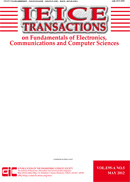Volume E99.A, Issue 3
Displaying 1-12 of 12 articles from this issue
- |<
- <
- 1
- >
- >|
Regular Section
-
Article type: PAPER
Subject area: Digital Signal Processing
2016 Volume E99.A Issue 3 Pages 683-690
Published: March 01, 2016
Released on J-STAGE: March 01, 2016
Download PDF (1308K) -
Article type: PAPER
Subject area: Digital Signal Processing
2016 Volume E99.A Issue 3 Pages 691-701
Published: March 01, 2016
Released on J-STAGE: March 01, 2016
Download PDF (2096K) -
Article type: PAPER
Subject area: Nonlinear Problems
2016 Volume E99.A Issue 3 Pages 702-709
Published: March 01, 2016
Released on J-STAGE: March 01, 2016
Download PDF (407K) -
Article type: PAPER
Subject area: Nonlinear Problems
2016 Volume E99.A Issue 3 Pages 710-719
Published: March 01, 2016
Released on J-STAGE: March 01, 2016
Download PDF (1623K) -
Article type: PAPER
Subject area: Cryptography and Information Security
2016 Volume E99.A Issue 3 Pages 720-732
Published: March 01, 2016
Released on J-STAGE: March 01, 2016
Download PDF (775K) -
Article type: PAPER
Subject area: Coding Theory
2016 Volume E99.A Issue 3 Pages 733-741
Published: March 01, 2016
Released on J-STAGE: March 01, 2016
Download PDF (760K) -
Article type: PAPER
Subject area: Neural Networks and Bioengineering
2016 Volume E99.A Issue 3 Pages 742-755
Published: March 01, 2016
Released on J-STAGE: March 01, 2016
Download PDF (3384K) -
Article type: LETTER
Subject area: Engineering Acoustics
2016 Volume E99.A Issue 3 Pages 756-759
Published: March 01, 2016
Released on J-STAGE: March 01, 2016
Download PDF (108K) -
Article type: LETTER
Subject area: Digital Signal Processing
2016 Volume E99.A Issue 3 Pages 760-764
Published: March 01, 2016
Released on J-STAGE: March 01, 2016
Download PDF (2014K) -
Article type: LETTER
Subject area: Coding Theory
2016 Volume E99.A Issue 3 Pages 765-769
Published: March 01, 2016
Released on J-STAGE: March 01, 2016
Download PDF (118K) -
Article type: LETTER
Subject area: Communication Theory and Signals
2016 Volume E99.A Issue 3 Pages 770-773
Published: March 01, 2016
Released on J-STAGE: March 01, 2016
Download PDF (348K) -
Article type: LETTER
Subject area: Image
2016 Volume E99.A Issue 3 Pages 774-776
Published: March 01, 2016
Released on J-STAGE: March 01, 2016
Download PDF (210K)
- |<
- <
- 1
- >
- >|
